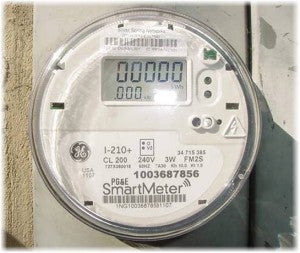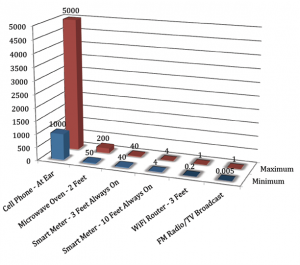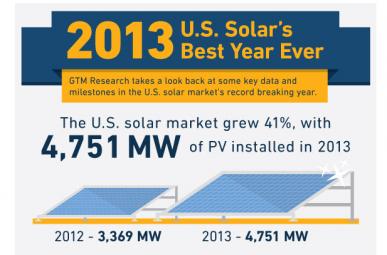Cassandra Brunette is a research associate in EDF’s Office of Chief Scientist.

Source: PG&E
A well-designed smart grid is critical to the clean energy revolution we need – enabling significantly greater use of clean, renewable, domestic energy resources and improved air quality to protect the health of millions of Americans now harmed by dangerous air pollution.
Smart meters are a key component of the smart grid. They unlock air quality, climate pollution and public health benefits by enabling two-way, real-time communication that gives households, small businesses, manufacturers and farmers (and the utilities that serve them) the information they need to cut energy use and electricity costs. These devices help ensure that every day energy users reap the many benefits of the smart grid.
However, as a recent PBS NewsHour report explained, some activist groups and individuals in areas where smart meters have been deployed have expressed concerns over exposure to radio frequencies (RFs) resulting from the use of this technology. EDF supports further research and opt-out programs for those concerned. But what is missing from the PBS report is a clear account of the current, available scientific evidence on smart meters and health. EDF uses the best available science in all of its programs, and our smart grid initiative is no exception.
I am a member of EDF’s science team out of the San Francisco Bay Area and have dug deep into the peer-reviewed literature on health effects of smart meters, as well as independent assessments by agencies and industry groups and reports from government agencies. Here is what we know:
Research shows that every day humans come into contact with RFs from a wide variety of sources, including – but not limited to – wireless or cellular phones, microwaves, wireless internet routers, hair dryers, baby monitors and wireless laptops. Each has varying levels of exposure that depend on the technology and – importantly – on distance from the source.
One example in our daily lives is the use of a cell phone. A study by the Electric Power Research Institute (EPRI) found that during a call, cell phones held at the ear generate exposure levels between 1000-5000 microwatts per square centimeter (µW/cm2). In comparison, when transmitting, smart meters create exposure levels of approximately 8.8 µW/cm2. And that’s if a person is standing right in front of the meter. In homes and businesses, people are much farther away from their electric meter, so exposure levels are far lower. This means that a cell phone call exposes a person to hundreds of times more RFs than a transmitting smart meter. Moreover, smart meters only transmit signals roughly 2-5% of the day (approximately 30-70 minutes).

Source: CCST
The chart to the right (units in µW/cm2), from a report by the California Council on Science and Technology, puts smart meters in context with other RF emitting technologies. Keep in mind that this chart compares smart meters at a hypothetical maximum exposure level with transmission occurring during 100% of the day. Even at these hypothetical maximums, exposure from smart meters is significantly lower than other technologies already in use.
Assessments also show that impacts from RFs come in two forms, thermal (heat-related) and non-thermal. The Federal Communications Commission (FCC) sets safety standards for thermal impacts. Smart meter exposure levels fall well below the FCC’s limits for safety for thermal impacts. As for non-thermal impacts, the cumulative impacts of low-dose, long-term exposure are uncertain. To date, there is no scientific evidence of non-thermal impacts from smart meter RF emissions. EDF supports continued research on any possible health impacts of all RF emitters, but given the current standard for thermal impacts and uncertainties of non-thermal impacts, there is no evidence that the public would benefit from additional standards.
EDF’s number one priority is environmental and public health safety. We advocate for a “smart grid done right” to quote a message by EDF’s President Fred Krupp, and we are not alone in this effort. Though the PBS NewsHour story references “environmentalists” broadly opposed to a smarter grid, EDF is one of many environmental organizations strongly advocating for grid modernization as the clear path to lessening our dependence on fossil fuels and moving us toward a clean, healthy, low-carbon energy system. Our science team will continue thorough assessments of the best available science on this topic and our work with utilities, regulators and the smart grid industry to protect the environment and the health of customers.
For more information on the many benefits of the smart grid, please view EDF’s fact sheet here.
 In a victory for Illinois residents and the environment, Commonwealth Edison Company (ComEd) today formally proposed to the Illinois Commerce Commission an accelerated timetable for completing its deployment of four million smart meters. ComEd began installing smart meters last fall as part of the Energy Infrastructure and Modernization Act of 2011. With this proposal, the Illinois utility will complete its meter installation almost five years earlier than planned.
In a victory for Illinois residents and the environment, Commonwealth Edison Company (ComEd) today formally proposed to the Illinois Commerce Commission an accelerated timetable for completing its deployment of four million smart meters. ComEd began installing smart meters last fall as part of the Energy Infrastructure and Modernization Act of 2011. With this proposal, the Illinois utility will complete its meter installation almost five years earlier than planned.












